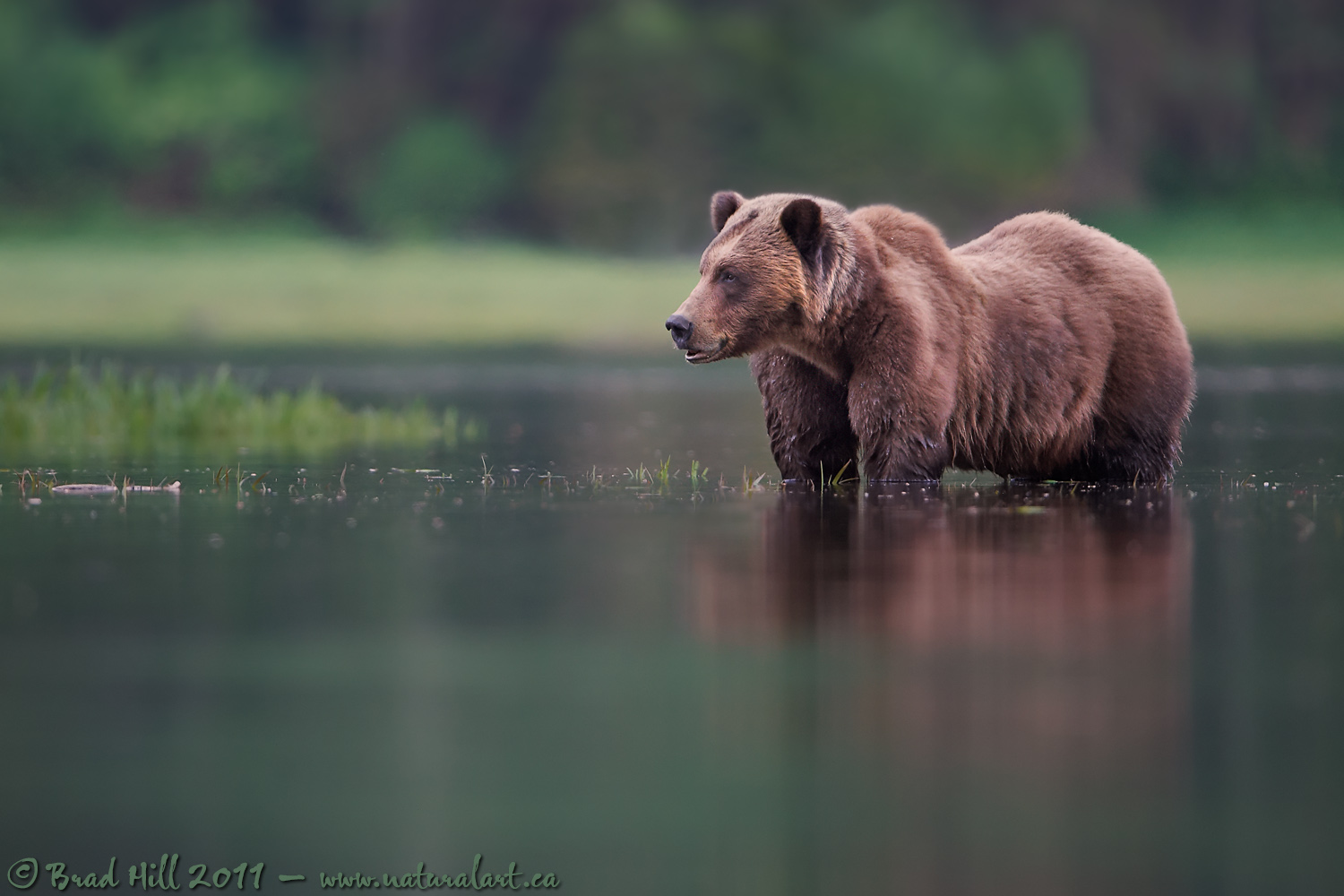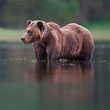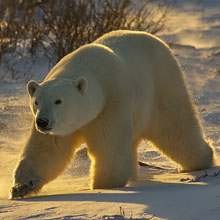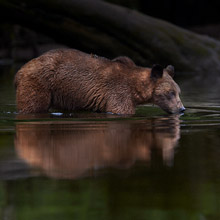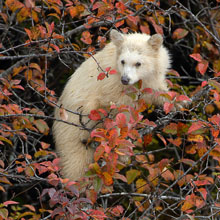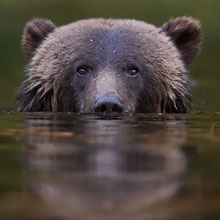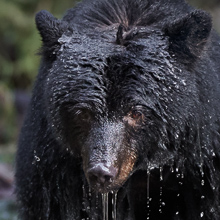Availability: Undetermined - Enquiries?
In the Field
At Peace in the Great Bear Rainforest. Khutzeymateen Inlet (Great Bear Rainforest), BC, Canada. June 2, 2009.
Sometimes the simplest looking images are the toughest to pull off! To me this shot just screams "Great Bear Rainforest" and goes a long way towards explaining why I return to the Great Bear Rainforest on an annual basis. As the largest remaining tract of temperate rainforest left on the planet (and virtually the ONLY one with all "original" members of it's historical ecosystem still present) it's just so spectacular and there's ALWAYS something new to photograph there.
I've had this shot (or one similar to it) sitting in my head for a LONG time - and it wasn't until the spring of 2009 that I actually got the opportunity to capture it. Between getting the soft light right, having a bear in the right spot, having the tide sitting at just the right level, and, of course, having the right gear ready to go...well..if you're persistent, eventually the planets have to align - right?
This was one of those very fortunate times when what I was forced to do (by the physical/technical constraints) perfectly matched what I WANTED to do with a shot. In this case, that basically meant shooting with the aperture on my lens wide open. I HAD to do this simply by the low levels of light - combined of course with my need to find as much shutter speed as possible - I shot this image while hand-holding a 600mm lens from a floating Zodiac and you don't want to pull that trick when shooting at a shutter speed of 1/30s!
I WANTED to shoot wide open to throw virtually everything in the image out-of-focus except the subject - I wanted the foreground and background as soft as possible to make the bear stand out (or "pop") AND to give the image a dreamy feel.
Personally, I find shooting wildlife images with a thin depth of field (or DoF) very challenging (and really, really easy to blow!). This is especially true with animalscapes where you're going to end up with much of the contents of the frame out-of-focus. I've never been a fan of images where there are very obvious multiple, distinct out-of-focus bands stretching from edge to edge of the frame. To me it often looks extremely unnatural and screams "telephoto lens" so loudly that this becomes the dominant visual impression left by the image. This is especially true if the out-of-focus foreground contains irregular objects, like rocks or trees that end up being little more than distracting blobs! To work for me, an animalscape with a paper thin DoF almost always requires a very simple foreground that extends BEYOND the subject and into the background. The background CAN, in some instances, contain some irregular objects without being particularly distracting and interfering with the eyeflow (but the background still has to be rendered very softly and the "irregularities" usually have to fall within the same overall colour palette).
In this case the most critical element allowing this image to work is the dark green water in the foreground that extends a significant distance into the background. Without this continuous water, or if there were any distracting elements in or on it (like floating logs or a protruding rock) and, in my opinion, this scene and image simply wouldn't have been worth shooting...
Here's a higher resolution (2400 pixel) version of the shot for those wanting to see more detail:
• At Peace in the Great Bear Rainforest Download 2400 pixel image (JPEG: 0.7 MB)
ADDITIONAL NOTES:
1. This image - in all resolutions - is protected by copyright. I'm fine with personal uses of them (including use as desktop backgrounds or screensavers on your own computer), but unauthorized commercial use of the image is prohibited by law. Thanks in advance for respecting my copyright!
2. This image was captured during one of my two spring "Grizzlies of the Khutzeymateen" photo tours in May/June of 2011. Each year I offer trips into two different parts of the Great Bear Rainforest as well as one to photograph aquatic mammals and oceanscapes near the northern tip of Vancouver Island. And, in selected years, I also offer photo tours to locations to capture other highly sought-after subjects, such as various boreal owl species and wildlife of Canada's Arctic. Details about these trips can be found on the Photo Tours page of this website.
3. Like all wildlife photographs on this website, this image was captured following the strict ethical guidelines described in The Wildlife FIRST! Principles of Photographer Conduct. I encourage all wildlife photographers to always put the welfare of their subjects above the value of their photographs.
Behind the Camera
At Peace in the Great Bear Rainforest. Khutzeymateen Inlet (Great Bear Rainforest), BC, Canada. June 2, 2009.
Digital Capture; RAW 14-bit format; ISO 1600.
Nikon D3 with Nikkor 600mm f4 VR lens - handheld from floating Zodiac boat. VR on and in "Normal" mode.
1/200s @ f4; no compensation from matrix-metered exposure setting.
At the Computer
At Peace in the Great Bear Rainforest. Khutzeymateen Inlet (Great Bear Rainforest), BC, Canada. June 2, 2009.
RAW Conversion to 16-bit TIFF, including first-pass/capture sharpening using Phase One's Capture One Pro 6. Two raw conversions varying in exposure settings: one at -1.0 stops to darken the foreground water and background (and to richen colours); one at -0.5 stops for bear.
Further digital corrections on 16-bit TIFF file using Adobe's Photoshop CS5 and Light Craft's LightZone. Photoshop adjustments included compositing the two exposure versions, selective exposure and tone curve adjustment, selective colour saturation and desaturation, and selective sharpening for web output. Final tonemapping and contrast/tone tweaking - especially to midtones - performed with LightZone using the tonemapper/re-light tool.
Conservation
At Peace in the Great Bear Rainforest. Khutzeymateen Inlet (Great Bear Rainforest), BC, Canada. June 2, 2009.
Ten percent of the revenue generated by this image will be donated to Raincoast*.
Species Status in Canada**: Special Concern (May 2002).
While Grizzly Bears (Ursus arctos) are not technically listed as "Endangered" in Canada, they have been extirpated from most of their historical range. Grizzly Bears are far more sensitive to intrusion/disturbance in their habitat than are Black Bears and are being increasingly forced into marginal habitat by human encroachment. The Great Bear Rainforest along the central and northern coast of British Columbia is one of the last strongholds of the Grizzly Bear in Canada, and even this population is coming under increasing pressure.
On December 18, 2017 the government of British Columbia banned grizzly hunting across the entire province. This major conservation victory came after decades of tireless work by many dedicated conservationists and ecologists and, most importantly, it reflects the opinion of the vast majority of British Columbians. And, it means that AT LEAST while the current government remains in power grizzlies are finally "safe" in British Columbia.
Now that we've at least temporarily won the battle to save grizzlies in BC, it's time to re-focus our efforts toward protecting ALL of BC's carnivores, including Gray Wolves, Black Bears, Cougars, Wolverines, and more! Simply put, there are no ecological, economic, or ethical arguments supporting the trophy hunting of carnivores.
In a great first step towards ending the hunting of carnivores throughout BC the Raincoast Conservation Foundation has developed a program designed to protect ALL carnivores within the Great Bear Rainforest. Details about this program can be found on this page on Raincoast's website. Check it out and, better yet, make a donation to help Raincoast purchase the remaining commercial hunting tenures in the Great Bear!
*The Raincoast Conservation Society (and Foundation) is an effective and efficient organization that has been fighting for protection of this unique habitat. If you are looking for a meaningful way to contribute to the conservation of this amazing ecosystem, Raincoast will provide maximal "bang" for your conservation dollars.
**as determined by COSEWIC: The Committee on the Status of Endangered Wildlife in Canada












